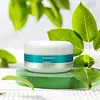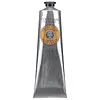What's inside
What's inside
 Key Ingredients
Key Ingredients

 Benefits
Benefits

 Concerns
Concerns

 Ingredients Side-by-side
Ingredients Side-by-side

Butyrospermum Parkii Butter
Skin ConditioningHelianthus Annuus Seed Oil
EmollientPrunus Amygdalus Dulcis Oil
Skin ConditioningCocos Nucifera Oil
MaskingUbiquinone
AntioxidantGlycine Soja Oil
EmollientLavandula Angustifolia Oil
MaskingCannabis Sativa Flower/Leaf/Stem Extract
AntioxidantTetrahexyldecyl Ascorbate
AntioxidantCamellia Sinensis Leaf Extract
AntimicrobialCucumis Sativus Fruit Extract
EmollientSclerocarya Birrea Seed Oil
HumectantTocopheryl Acetate
AntioxidantBorago Officinalis Extract
EmollientHedera Helix Leaf/Stem Extract
AntimicrobialButyrospermum Parkii Butter, Helianthus Annuus Seed Oil, Prunus Amygdalus Dulcis Oil, Cocos Nucifera Oil, Ubiquinone, Glycine Soja Oil, Lavandula Angustifolia Oil, Cannabis Sativa Flower/Leaf/Stem Extract, Tetrahexyldecyl Ascorbate, Camellia Sinensis Leaf Extract, Cucumis Sativus Fruit Extract, Sclerocarya Birrea Seed Oil, Tocopheryl Acetate, Borago Officinalis Extract, Hedera Helix Leaf/Stem Extract
Water
Skin ConditioningButyrospermum Parkii Butter
Skin ConditioningGlycerin
HumectantTapioca Starch
Helianthus Annuus Seed Oil
EmollientGlyceryl Stearate Se
EmulsifyingOctyldodecanol
EmollientLavandula Angustifolia Oil
MaskingHeterotheca Inuloides Flower Extract
MaskingCocos Nucifera Oil
MaskingHydroxyethyl Acrylate/Sodium Acryloyldimethyl Taurate Copolymer
Emulsion StabilisingPropylene Glycol
HumectantSodium Stearoyl Glutamate
CleansingXanthan Gum
EmulsifyingTocopherol
AntioxidantPanthenol
Skin ConditioningPolysorbate 60
EmulsifyingSorbitan Isostearate
EmulsifyingCitric Acid
BufferingEthylhexylglycerin
Skin ConditioningSorbitol
HumectantPhenoxyethanol
PreservativeBenzoic Acid
MaskingDehydroacetic Acid
PreservativeParfum
MaskingLinalool
PerfumingGeraniol
PerfumingLimonene
PerfumingCitronellol
PerfumingWater, Butyrospermum Parkii Butter, Glycerin, Tapioca Starch, Helianthus Annuus Seed Oil, Glyceryl Stearate Se, Octyldodecanol, Lavandula Angustifolia Oil, Heterotheca Inuloides Flower Extract, Cocos Nucifera Oil, Hydroxyethyl Acrylate/Sodium Acryloyldimethyl Taurate Copolymer, Propylene Glycol, Sodium Stearoyl Glutamate, Xanthan Gum, Tocopherol, Panthenol, Polysorbate 60, Sorbitan Isostearate, Citric Acid, Ethylhexylglycerin, Sorbitol, Phenoxyethanol, Benzoic Acid, Dehydroacetic Acid, Parfum, Linalool, Geraniol, Limonene, Citronellol
 Reviews
Reviews

Alternatives
Ingredients Explained
These ingredients are found in both products.
Ingredients higher up in an ingredient list are typically present in a larger amount.
This ingredient is also known as shea butter. It is an effective skin hydrator and emollient.
Emollients help soothe and soften your skin. It does this by creating a protective film on your skin. This barrier helps trap moisture and keeps your skin hydrated. Emollients may be effective at treating dry or itchy skin.
Shea butter is rich in antioxidants. Antioxidants help fight free-radicals, or molecules that may harm the body. It is also full of fatty acids including stearic acid and linoleic acid. These acids help replenish the skin and keep skin moisturized.
While Shea Butter has an SPF rating of about 3-4, it is not a sunscreen replacement.
Shea butter may not be fungal acne safe. We recommend speaking with a professional if you have any concerns.
Learn more about Butyrospermum Parkii ButterCocos Nucifera Oil is obtained from the kernels of the coconut fruit. In other words, this is coconut oil.
Coconut Oil is rich in fatty acids with lauric acid making up the majority of these. It also contains linoleic acid. Due to this high fatty acid content, coconut oil helps trap moisture and soften skin.
Despite being antibacterial, coconut oil may not be great for acne-prone skin. It is comedogenic and may clog pores. This ingredient may not be safe for malassezia or fungal acne.
Note: Coconut Oil should not replace your sunscreen for UV protection. Studies show it only blocks about 20% of UV.
This oil is non-volatile and has a light scent.
The term 'fragrance' is not regulated in many countries. In many cases, it is up to the brand to define this term. For instance, many brands choose to label themselves as "fragrance-free" because they are not using synthetic fragrances. However, their products may still contain ingredients such as essential oils that are considered a fragrance.
Learn more about Cocos Nucifera OilHelianthus Annuus Seed Oil is the oil derived from the seeds of a Sunflower. Sunflower seed oil is non-fragrant. It is an emollient, meaning it helps to soften the skin.
Sunflower seed oil contains many fatty acids. The fatty acids found in sunflower seeds include (from highest amount to least): linoleic acid, myristic acid, palmitic acid, stearic acid, arachidic acid, oleic acid, and linolenic acid.
These fatty acids help the skin create ceramides. Ceramides play a role in repairing the skin barrier.
Helianthus Annuus Seed Oil helps moisturize the skin. This in turn helps the skin look more rejuvenated and smoother.
Sunflowers are rich in vitamin E.
Historians believe Indigenous cultures of North America domesticated sunflowers before corn. Thus they relied on sunflower oil for a variety of uses. One such use is moisturizing skin and hair.
Sunflower seed oil may not be fungal acne safe. We recommend speaking with a professional if you have any concerns.
Learn more about Helianthus Annuus Seed OilLavandula Angustifolia Oil is more commonly known as lavender essential oil. It is considered a fragrancing ingredient.
Lavender imparts a famous scent. While the smell is lovely, this ingredient and may sensitize skin in topical products. This is because about 85% of the oil is made up of linalool and linalyl acetate.
When exposed to air, these two compounds become strong allergens. This ingredient exhibits cytotoxicity at low concentrations; amounts of 0.25% have been shown to damage skin cells.
A study from Japan found this ingredient caused lavender sensitivity after widespread exposure.
Lavender essential oil has some antimicrobial, antibacterial, and anti-inflammatory properties. However, the cons of this ingredient may outweight the pros.
More research is needed to confirm lavender essential oil's effects when used in aromatherapy.
Lavandula Angustifolia is known as the English Lavender and famous for creating purple fields in Provence, France.
Learn more about Lavandula Angustifolia Oil